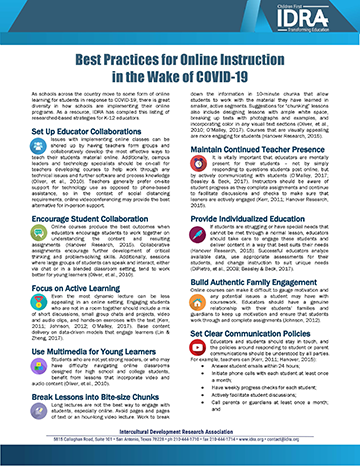Online education has transformed learning. It’s more accessible and flexible now.
In today’s digital age, many students and teachers rely on online education. It offers great benefits, but also has challenges. To succeed, you need to follow certain best practices. These can help create a productive learning environment. Both students and educators can benefit from understanding these methods.
From effective communication to choosing the right tools, many factors play a role. This blog will explore the key practices for achieving success in online education. Whether you’re a student or an educator, you’ll find valuable tips to enhance your online learning experience. Let’s dive into the best practices that make online education effective and rewarding.
Introduction To Online Education
Online education has transformed the learning landscape. It offers flexibility and accessibility. Students can learn from anywhere in the world. The rise of technology has made this possible. Let’s explore the best practices in online education.
Rise Of Virtual Learning
Virtual learning has seen tremendous growth. Schools and universities are adopting it. The internet connects students and teachers. This creates a global classroom.
The COVID-19 pandemic accelerated this shift. Many institutions had to go online. This showed the need for digital learning tools. Virtual learning is now a key part of education.
Benefits Of Online Education
Online education offers many benefits. Here are some key advantages:
- Flexibility: Students can learn at their own pace.
- Accessibility: Education reaches remote areas.
- Cost-Effective: Saves on travel and accommodation.
- Variety of Courses: A wide range of subjects available.
Let’s look at these benefits in detail:
| Benefit | Details |
|---|---|
| Flexibility | Students can choose their study time. This helps balance work and study. |
| Accessibility | Online courses are available worldwide. Learners can access from any location. |
| Cost-Effective | Reduces the need for physical classrooms. Saves money on travel and accommodation. |
| Variety of Courses | Students have a wide range of subjects to choose from. |
These benefits make online education a preferred choice. It suits different learning styles and needs.
Effective Online Teaching Strategies
Online education is evolving rapidly. Effective online teaching strategies are crucial for student success. These strategies enhance engagement, understanding, and retention. Let’s explore key strategies for effective online teaching.
Interactive Content
Interactive content keeps students engaged. It encourages participation and active learning. Use quizzes, polls, and discussions. These tools make learning fun and interactive.
Consider using multimedia. Videos, infographics, and animations can explain concepts better. They cater to different learning styles. Create content that students can interact with and explore.
Incorporate practical exercises. Real-world examples help students understand theoretical concepts. Case studies and simulations can be very effective.
Engaging Delivery Methods
Engaging delivery methods make learning more effective. Use a mix of synchronous and asynchronous methods. Live sessions allow real-time interaction. Recorded lessons provide flexibility.
Personalize the learning experience. Address students by name. Provide timely feedback. This makes students feel valued and motivated.
Use breakout rooms during live sessions. Small group discussions enhance understanding. Peer interactions can provide different perspectives.
Incorporate gamification elements. Use badges, leader boards, and rewards. These elements increase motivation and participation.
Ensure content is mobile-friendly. Many students access courses via mobile devices. Responsive design is essential for accessibility.
Effective online teaching requires a blend of strategies. Interactive content and engaging delivery methods are key. Implement these practices for a successful online education experience.
Student Engagement Techniques
Engaging students in online education is essential for effective learning. Keeping students involved can be challenging. But, there are techniques to boost their engagement and learning outcomes.
Active Participation
Active participation is crucial in online education. It keeps students attentive and involved. Here are some methods to ensure active participation:
- Interactive Discussions: Encourage students to join in discussions. Use forums and live chats.
- Quizzes and Polls: Regular quizzes and polls help check understanding. They keep students engaged.
- Video Responses: Ask students to respond with video. It makes them more interactive.
- Real-time Feedback: Provide instant feedback on assignments. It helps in improving quickly.
Collaborative Learning
Collaborative learning fosters teamwork and better understanding. It helps students learn from each other. Here are some techniques to encourage collaborative learning:
- Group Projects: Assign projects that require group work. This builds teamwork skills.
- Peer Reviews: Have students review each other’s work. It encourages critical thinking.
- Discussion Boards: Create spaces for students to discuss topics. It promotes knowledge sharing.
- Virtual Study Groups: Encourage students to form study groups. They can meet online to study together.
Implementing these techniques can significantly improve student engagement in online education. Active participation and collaborative learning are key to success.
Technology In Virtual Learning
Technology plays a key role in virtual learning. It provides the tools and platforms needed for effective online education. With the right technology, students can learn and teachers can teach from anywhere in the world.
Essential Tools
Several tools are essential for virtual learning. These tools help in communication, collaboration, and content delivery. Below are some of the most important ones:
- Video Conferencing Software: Tools like Zoom and Google Meet allow live interaction between teachers and students.
- Learning Management Systems (LMS): Platforms like Moodle and Canvas help in organizing course materials and tracking student progress.
- Digital Whiteboards: Tools like Microsoft Whiteboard and Jamboard enhance visual learning.
- File Sharing Services: Google Drive and Dropbox make sharing and accessing documents easier.
Innovative Platforms
Innovative platforms offer unique features for online education. They cater to different learning styles and needs. Here are some noteworthy platforms:
- Khan Academy: Free educational resources for students of all ages.
- Coursera: Online courses from top universities and companies.
- Duolingo: Language learning with gamification elements.
- edX: University-level courses in a wide range of subjects.
| Platform | Feature |
|---|---|
| Khan Academy | Free educational resources |
| Coursera | University courses |
| Duolingo | Language learning |
| edX | Wide range of subjects |
Using these tools and platforms can enhance the virtual learning experience. They make learning more interactive and accessible.
Assessment And Feedback
Effective assessment and feedback are cornerstones of successful online education. They help students understand their progress and areas for improvement. Proper assessment methods and timely feedback can enhance student engagement and learning outcomes.
Formative Assessments
Formative assessments are essential in online education. They provide continuous feedback to students. This helps them gauge their understanding throughout the course. These assessments can be in various forms, such as:
- Quizzes
- Short assignments
- Discussion posts
- Interactive activities
Using diverse assessment methods keeps students engaged. It caters to different learning styles. Regular formative assessments help identify gaps in knowledge early on.
Timely Feedback
Timely feedback is crucial for student improvement. It should be clear, constructive, and actionable. Feedback must be provided within a reasonable timeframe. This keeps the learning momentum going.
Here are some best practices for providing timely feedback:
- Set clear expectations on feedback timelines.
- Use rubrics to provide consistent and detailed feedback.
- Incorporate peer reviews to enhance feedback diversity.
- Utilize technology tools for quicker feedback delivery.
Feedback should highlight strengths and suggest areas for improvement. It encourages students to reflect on their work. This fosters a growth mindset and continuous learning.
In summary, effective assessment and feedback are integral to online education success. Formative assessments and timely feedback ensure students stay engaged and improve their skills.

Credit: www.psglearning.com
Challenges In Online Education
Online education offers flexibility and accessibility. Yet, it also brings significant challenges. These challenges can impact both students and educators. Understanding these challenges is crucial for effective online learning.
Technical Issues
Technical problems are common in online education. Poor internet connection can disrupt classes. Students may miss important information. Device compatibility is another issue. Not all students have access to updated devices. This can limit their ability to participate fully.
Software glitches can also hinder learning. Sometimes, educational platforms have bugs. These bugs can cause frustration and delay learning. Teachers and students need reliable tech support. Quick fixes are essential to keep classes running smoothly.
Student Isolation
Student isolation is a significant challenge. Online education can feel lonely. Students miss out on face-to-face interactions. This can affect their mental health and motivation.
Lack of peer interaction is another issue. Group work and discussions are harder online. Students may feel disconnected from their classmates. This can impact their learning experience.
Teacher-student interaction is also limited. In-person feedback is more effective. Online, it’s harder to build strong relationships. This can affect student engagement and performance.
Building An Online Learning Community
Building an online learning community is essential for successful online education. This community helps students feel connected, supported, and engaged. It fosters collaboration, motivates learners, and creates a sense of belonging.
Fostering Connections
Creating connections between students is crucial. Here are a few best practices:
- Discussion Forums: Encourage students to participate in discussion forums. This allows them to share ideas and ask questions.
- Group Projects: Assign group projects to foster teamwork. This helps students learn from each other.
- Virtual Meetups: Host regular virtual meetups. This gives students a chance to interact in real-time.
- Icebreaker Activities: Use icebreaker activities to help students get to know each other.
Support Systems
Support systems are vital for student success. Consider these strategies:
- Mentorship Programs: Pair students with mentors. Mentors can provide guidance and support.
- Help Desks: Set up a virtual help desk. This allows students to get help quickly when they face issues.
- Resource Libraries: Create a resource library with helpful materials. This can include tutorials, guides, and FAQs.
- Feedback Mechanisms: Implement feedback mechanisms. This allows students to share their concerns and suggestions.
Building an online learning community requires effort and dedication. Fostering connections and establishing support systems are key practices. They ensure that students feel connected and supported throughout their learning journey.

Credit: www.gettingsmart.com
Future Of Online Education
The future of online education is promising. Technology continues to advance rapidly. More people are embracing online learning. This trend shows no signs of slowing down. Let’s explore the key trends and evolving practices shaping the future.
Trends And Predictions
Several trends and predictions are emerging in online education. These changes will shape how we learn and teach.
- AI and Machine Learning: AI will personalize learning experiences. Machine learning can adapt content to individual needs.
- Virtual Reality (VR): VR will make learning more immersive. It creates real-world scenarios for students.
- Microlearning: Short, focused lessons are becoming popular. These bite-sized lessons are easier to digest.
- Gamification: Adding game elements to learning increases engagement. It makes learning fun and interactive.
- Blockchain Technology: Blockchain can secure educational records. It ensures the authenticity of certificates and degrees.
Evolving Practices
Education practices are evolving to meet new demands. Here are some key changes we can expect.
- Flexible Learning Paths: Students will have more control over their learning paths. They can choose courses that match their interests and goals.
- Collaborative Learning: Online platforms will enhance collaboration. Students can work together on projects and share ideas.
- Continuous Assessment: Traditional exams are giving way to continuous assessment. This provides regular feedback and supports ongoing improvement.
- Focus on Soft Skills: Online education will emphasize soft skills. Communication, teamwork, and problem-solving are crucial in today’s world.
- Hybrid Learning Models: Combining online and face-to-face learning offers the best of both worlds. This approach caters to different learning styles.
| Trend | Impact |
|---|---|
| AI and Machine Learning | Personalized learning |
| Virtual Reality | Immersive experiences |
| Microlearning | Focused, short lessons |
| Gamification | Increased engagement |
| Blockchain Technology | Secure records |

Credit: www.idra.org
Frequently Asked Questions
What Are The Key Benefits Of Online Education?
Online education offers flexibility, accessibility, and a wide range of courses. It’s convenient and often more affordable.
How Can Students Stay Motivated In Online Classes?
Set goals, create a study schedule, and take regular breaks. Stay engaged by participating in discussions.
What Tools Are Essential For Online Learning?
Reliable internet, a computer or tablet, and necessary software. Headphones and a quiet space help too.
How Do Online Courses Compare To Traditional Classes?
Online courses offer flexibility and can be just as effective. They require self-discipline and time management.
What Strategies Help Improve Online Learning?
Interactive lessons, regular feedback, and active participation. Utilize resources and stay organized.
How Can Teachers Engage Students In Virtual Classrooms?
Use multimedia, interactive activities, and real-time feedback. Encourage group work and discussions.
What Are The Challenges Of Online Education?
Technical issues, lack of social interaction, and self-motivation. Time management is also crucial.
Conclusion
Online education thrives on best practices. Consistent engagement helps students succeed. Clear communication is key. Interactive tools enhance learning experiences. Flexibility supports diverse needs. Regular feedback keeps progress on track. Collaboration fosters community. Quality resources make a difference. Adopting these practices can improve online education outcomes.
Stay dedicated to creating a supportive environment. Teachers and students benefit from these efforts. Implement these strategies for better results. Embrace the future of learning.



